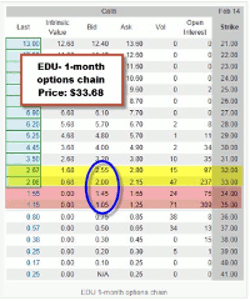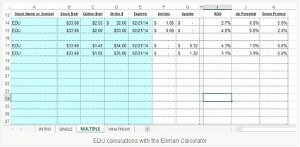To maximize our covered call writing returns, we must master strike price selection, says option expert Alan Ellman of TheBlueCollarInvestor.com.
In our BCI methodology, strike price selection is ultimately determined after our careful stock screening analysis and overall market assessment. By developing a watch list of eligible candidates with elite fundamentals and strong price chart technicals along with passing our common-sense screens (like minimum trading volume) we are off to a great start in constructing our monthly covered call writing portfolios. Next we make our overall market assessment (bullish vs. bearish) and that will dictate the percentage of in-the-money (ITM- conservative) and out-of-the-money (OTM- bullish) strikes we will select.
Whether we are favoring ITM or OTM strikes we may have several choices to choose from. So the question now becomeswhich specific strike price should we select? At this point the calculations become a key factor. The first consideration is to decide what your initial one-month goals are for your positions (mine are 2-4%). From there, we look at the amount of upside potential if bullish or the amount of downside protection of the option profit if bearish or have a low-risk tolerance. Let's make some generalizations:
- The more bullish we are, the further OTM we will go
after meeting our initial goals
- The more bearish we are, the further ITM we will go
after meeting our initial goals
Let's look at a real-life example, using New Oriental Education & Technology Group (EDU), a stock on our Premium watch List at the time I wrote this article. Below is a one-month options chain:
Note the following:
- EDU is trading @ $33.68
- We will evaluate ITM strikes of $32 and $33 (yellow
fields)
- We will evaluate OTM strikes of $34 and $35 (pink
fields)
- We will use the published "bid" prices with the
understanding that we can frequently negotiate better sale prices
Next, let's take these stats and enter them into the Ellman Calculator:
Note the following:
- All initial returns meet the goal of 2-4%
- The more bearish or conservative an investor is, the
more likely he (she) is to select the $32 strike and sacrifice some initial
return for more protection
- The more bullish an investor is, the more likely he
(she) is to select the $35 strike to create an opportunity for greater upside
and a potential 7%, one-month return (3.1% + 3.9%).
Summary
The key takeaway here is that there is no one strike price that is best suited for every investor. The factors that need to be considered are:
- Overall market assessment
- Personal risk tolerance
- Individual monthly goals
By factoring in these considerations we will be able to make an appropriate decision for ourselves based on sound fundamental, technical, and common sense principles.
By Alan Ellman of TheBlueCollarInvestor.com























